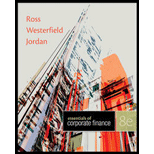
Essentials of Corporate Finance
8th Edition
ISBN: 9780078034756
Author: Stephen A. Ross, Randolph W. Westerfield, Bradford D. Jordan
Publisher: MCGRAW-HILL HIGHER EDUCATION
expand_more
expand_more
format_list_bulleted
Question
Chapter 4, Problem 4CTCR
Summary Introduction
To discuss: The
Introduction:
The future value of money refers to the amount of dollars that an investment grows over a definite period at a particular rate of interest rate. In other words, it refers to the future value of present cash investments.
Expert Solution & Answer
Want to see the full answer?
Check out a sample textbook solution
Students have asked these similar questions
Question:
A company has issued a bond with a face value of $1,000, a coupon rate of 5%, and a maturity of 10 years. If the bond is currently trading at $950, what is the bondholder's yield to maturity (YTM), and how does it differ from the coupon rate? need help!!
A company has issued a bond with a face value of $1,000, a coupon rate of 5%, and a maturity of 10 years. If the bond is currently trading at $950, what is the bondholder's yield to maturity (YTM), and how does it differ from the coupon rate?
What is the time value of money, and why is it important in financial decision-making? Need help!
Chapter 4 Solutions
Essentials of Corporate Finance
Ch. 4 - Prob. 4.1ACQCh. 4 - Prob. 4.1BCQCh. 4 - In general, what is the future value of 1 invested...Ch. 4 - What do we mean by the present value of an...Ch. 4 - Prob. 4.2BCQCh. 4 - Prob. 4.2CCQCh. 4 - Prob. 4.2DCQCh. 4 - What is the basic present value equation?Ch. 4 - Prob. 4.3BCQCh. 4 - Prob. 4.1C
Ch. 4 - Prob. 4.2CCh. 4 - Prob. 4.3CCh. 4 - Prob. 1CTCRCh. 4 - Prob. 2CTCRCh. 4 - Prob. 3CTCRCh. 4 - Prob. 4CTCRCh. 4 - Prob. 5CTCRCh. 4 - Prob. 6CTCRCh. 4 - Prob. 7CTCRCh. 4 - Prob. 8CTCRCh. 4 - Prob. 9CTCRCh. 4 - Prob. 10CTCRCh. 4 - Prob. 1QPCh. 4 - Prob. 2QPCh. 4 - Prob. 3QPCh. 4 - Prob. 4QPCh. 4 - Prob. 5QPCh. 4 - Prob. 6QPCh. 4 - Prob. 7QPCh. 4 - Prob. 8QPCh. 4 - Prob. 9QPCh. 4 - Prob. 10QPCh. 4 - Prob. 11QPCh. 4 - Prob. 12QPCh. 4 - Prob. 13QPCh. 4 - Prob. 14QPCh. 4 - Prob. 15QPCh. 4 - Prob. 16QPCh. 4 - Prob. 17QPCh. 4 - Prob. 18QPCh. 4 - Prob. 19QPCh. 4 - Prob. 20QPCh. 4 - Prob. 21QPCh. 4 - Prob. 22QPCh. 4 - Prob. 23QPCh. 4 - Prob. 24QPCh. 4 - Prob. 25QPCh. 4 - Calculating Future Values. You have 20,000 you...
Knowledge Booster
Similar questions
- What is the time value of money, and why is it important in financial decision-making?arrow_forwardPlease don't use chatgpt. The formula for calculating the present value of a future amount is:A) Future Value × (1 + r)^nB) Future Value ÷ (1 + r)^nC) Future Value × (1 - r)^nD) Future Value ÷ (1 - r)^n help in this question.arrow_forwardThe formula for calculating the present value of a future amount is:A) Future Value × (1 + r)^nB) Future Value ÷ (1 + r)^nC) Future Value × (1 - r)^nD) Future Value ÷ (1 - r)^n need help!arrow_forward
- no ai What is the primary purpose of diversification in investing?A) To maximize returnsB) To eliminate all riskC) To reduce unsystematic riskD) To ensure stable dividendsarrow_forwardno chatgpt Which of the following is a capital structure decision?A) Deciding how much to pay in dividendsB) Deciding how to allocate funds to various projectsC) Deciding the mix of debt and equity financingD) Deciding how much inventory to purchase need help!arrow_forwardWhich of the following is a capital structure decision?A) Deciding how much to pay in dividendsB) Deciding how to allocate funds to various projectsC) Deciding the mix of debt and equity financingD) Deciding how much inventory to purchasearrow_forward
- No chatgpt!! The weighted average cost of capital (WACC) is used to:A) Measure the profitability of a companyB) Determine the cost of debt financing onlyC) Calculate the company’s average cost of financing from debt and equityD) Estimate the future stock price need help.arrow_forwardNo AI The weighted average cost of capital (WACC) is used to:A) Measure the profitability of a companyB) Determine the cost of debt financing onlyC) Calculate the company’s average cost of financing from debt and equityD) Estimate the future stock pricearrow_forwardCost of Trade Credit A large retailer obtains merchandise under the credit terms of 3/20, net 35, but routinely takes 65 days to pay its bills. (Because the retailer is an important customer, suppliers allow the firm to stretch its credit terms.) What is the retailer's effective cost of trade credit? Assume a 365-day year. Do not round intermediate calculations. Round your answer to two decimal places. The answer is not 27.09 which is incorrect.arrow_forward
- You invest $1,000 a year for 10 years at 6 percent and then invest $2,000 a year for an additional 10 years at 6 percent. How much will you have accumulated at the end of the 20 years? Answer: $49,967 *Please include all work & formulasarrow_forwardNo ai please! What is the role of an underwriter in an IPO?A) To lend money to the companyB) To set the dividend policyC) To buy the securities and sell them to the publicD) To manage the company’s operations need hearrow_forwardNo ai tool What is the role of an underwriter in an IPO?A) To lend money to the companyB) To set the dividend policyC) To buy the securities and sell them to the publicD) To manage the company’s operationsarrow_forward
arrow_back_ios
SEE MORE QUESTIONS
arrow_forward_ios
Recommended textbooks for you
 Intermediate Financial Management (MindTap Course...FinanceISBN:9781337395083Author:Eugene F. Brigham, Phillip R. DavesPublisher:Cengage Learning
Intermediate Financial Management (MindTap Course...FinanceISBN:9781337395083Author:Eugene F. Brigham, Phillip R. DavesPublisher:Cengage Learning EBK CONTEMPORARY FINANCIAL MANAGEMENTFinanceISBN:9781337514835Author:MOYERPublisher:CENGAGE LEARNING - CONSIGNMENT
EBK CONTEMPORARY FINANCIAL MANAGEMENTFinanceISBN:9781337514835Author:MOYERPublisher:CENGAGE LEARNING - CONSIGNMENT

Intermediate Financial Management (MindTap Course...
Finance
ISBN:9781337395083
Author:Eugene F. Brigham, Phillip R. Daves
Publisher:Cengage Learning

EBK CONTEMPORARY FINANCIAL MANAGEMENT
Finance
ISBN:9781337514835
Author:MOYER
Publisher:CENGAGE LEARNING - CONSIGNMENT